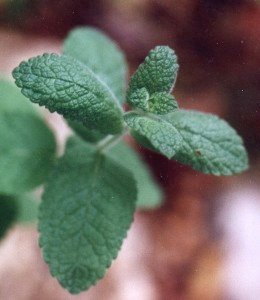Couple of Mints
by Valerie (October 20, 2002)
There are numerous mints that can be grown in our climate, but we have had success with just two so far. These are not the usual peppermint or spearmint, although I planted some peppermint, which is just barely surviving, probably because of lack of sun and water.

My favorite of these two plants is apple mint (Mentha suaveolens or Mentha rotundifolia). As is usually the case, because I like this plant, it doesn't proliferate as much as some others. Apple mint, sometimes also called woolly apple mint, has soft, velvety, scalloped edge leaves, a mild, fruity aroma, and rarely flowers, as it gets very little sun where it is growing. Because it needs a bit more water, it only thrives right next to one of our small water dishes, which I fill on a regular basis. The plants grow thin and spindly, but still have a nice smell. This is one of many plants that pose a dilemma for us. They require sun AND moist soil. Well, if we plant them in a sunny place, there is no way the soil will stay moist. There is a chance of the ground remaining slightly moist in the shade, but then we're missing the sunshine factor. In spite of less than ideal conditions, apple mint is a perennial and spreads nicely underground. It is not at all invasive because it never grows away from its water supply. Mints contain complex compounds that produce the familiar odors. These are called terpenes. Several plants in the genus Mentha have a significant percentage of menthol molecules. These are the peppermints. Others have carvone molecules, as found in spearmint, including apple mint. These familiar garden mints are all imported and are not native to the U.S., although some manage to naturalize successfully.
The other mint we cultivate is one such naturalized plant. There are about two dozen species of mountain mints that grow throughout the U.S. The one we have in our gardens is short-toothed mountain mint (Pycnanthemum muticum), which I've never seen growing wild in this area, but has a range throughout much of the eastern part of the country. Other names for this plant are silver mountain mint and clustered mountain mint. This plant has a large range and can withstand extreme cold as well as heat. It does not need much water and thrives in our gardens, to the point of being so invasive that I've had to pull some out because it is crowding other plants. It extends long rhizomes (which have a reddish color) just below the surface of the soil and so is very easy to remove.
Mountain mint has stiff, upright stems and smooth green leaves, growing to only about one foot in height. However, as the tops of the plants mature, the upper leaves take on a very silvery color. In spite of getting only partial sun, the flowers bloom for a long period during the summer, producing large numbers of buds that are compacted together in dense clusters, which increase in diameter as the season progresses. Although the blossoms are tiny, they are of typical mint form. The smell of these plants is rather strong and I don't find it particularly pleasant. In spite of that, it is a good plant for dry gardens and the odd flower heads and unusual shades of green are most interesting additions. |
